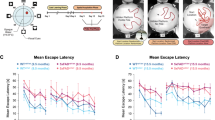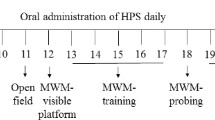Abstract
Cerebrovascular dysfunction is an early pathogenic event in Alzheimer’s disease (AD) and plays a key role in the disease process. Cerebral hypoperfusion, brain glucose hypometabolism and disrupted blood–brain barrier (BBB) integrity contributed to the onset and progression of AD. However, the relationships between the age-related cognitive impairment and cerebral blood flow (CBF), energy metabolism and BBB have not been clearly explained. In this study, we investigated the cognitive function, CBF, BBB damage and expression level of glucose transporter (GLUT) 1 and 3 of senescence-accelerated mouse prone 8 (SAMP8), and the correlations between each of them were analyzed. When compared with SAMR1 (senescence-accelerated mouse resistant 1), the cognitive abilities of SAMP8 were damaged apparently even at 4 months of age, showing up a slower and more capricious acquisition in Morris water maze tasks. In both SAMP8 and SAMR1, reduced CBF and increased BBB leakage were observed with increasing age, but an earlier and more severe impairment was detected in SAMP8. In addition, alterations of GLUT1 and GLUT3 protein expression in cortex and hippocampus were more prominent in SAMP8. Correlation analysis demonstrated that the increased escape latency was correlated negatively with CBF and expression of glucose transporters; and positively with BBB permeability in the hippocampus. These results suggested that CBF, BBB integrity, the expression of GLUT1 and GLUT3 were significantly affected by age and strain, which were also closely associated with cognitive ability. The alteration in CBF and energy failure induced by aging and vascular insults resulted in cognitive decline in SAMP8.





Similar content being viewed by others
References
Scheibel AB, Duong TH, Jacobs R (1989) Alzheimer’s disease as a capillary dementia. Ann Med 21:103–107
de la Torre JC (2004) Is Alzheimer’s disease a neurodegenerative or a vascular disorder? data, dogma, and dialectics. Lancet Neurol 3:184–190
Johnson NA, Jahng GH, Weiner MW, Miller BL, Chui HC, Jagust WJ, Gorno-Tempini ML, Schuff N (2005) Pattern of cerebral hypoperfusion in Alzheimer disease and mild cognitive impairment measured with arterial spin-labeling MR imaging: initial experience. Radiology 234:851–859
Ruitenberg A, den Heijer T, Bakker SL, van Swieten JC, Koudstaal PJ, Hofman A, Breteler MM (2005) Cerebral hypoperfusion and clinical onset of dementia: the rotterdam study. Ann Neurol 57(6):789–794
Hirao K, Ohnishi T, Hirata Y, Yamashita F, Mori T, Moriguchi Y, Matsuda H, Nemoto K, Imabayashi E, Yamada M, Iwamoto T, Arima K, Asada T (2005) The prediction of rapid conversion to Alzheimer’s disease in mild cognitive impairment using regional cerebral blood flow SPECT. Neuroimage 28:1014–1021
Mosconi L, De Santi S, Li J, Tsui WH, Li Y, Boppana M, Laska E, Rusinek H, de Leon MJ (2008) Hippocampal hypometabolism predicts cognitive decline from normal aging. Neurobiol Aging 29(5):676–692
Mosconi L, Sorbi S, de Leon MJ, Li Y, Nacmias B, Myoung PS, Tsui W, Ginestroni A, Bessi V, Fayyazz M, Caffarra P, Pupi A (2006) Hypometabolism exceeds atrophy in presymptomatic early-onset familial Alzheimer’s disease. J Nucl Med 47(11):1778–1786
Blass JP (2002) Alzheimer’s disease and Alzheimer’s dementia: distinct but overlapping entities. Neurobiol Aging 23(6):1077–1084
Mosconi L, Tsui WH, De Santi S, Li J, Rusinek H, Convit A, Li Y, Boppana M, de Leon MJ (2005) Reduced hippocampal metabolism in MCI and AD: automated FDG-PET image analysis. Neurology 64(11):1860–1867
Mosconi L, De Santi S, Brys M, Tsui WH, Pirraglia E, Glodzik-Sobanska L, Rich KE, Switalski R, Mehta PD, Pratico D, Zinkowski R, Blennow K, de Leon MJ (2008) Hypometabolism and altered cerebrospinal fluid markers in normal apolipoprotein E E4 carriers with subjective memory complaints. Biol Psychiatry 63(6):609–618
Desgranges B, Baron JC, de la Sayette V, Petit-Taboué MC, Benali K, Landeau B, Lechevalier B, Eustache F (1998) The neural substrates of memory systems impairment in Alzheimer’s disease: a PET study of resting brain glucose utilization. Brain 121(Pt4):611–631
Morley JE, Kumar VB, Bernardo AE, Farr SA, Uezu K, Tumosa N, Flood JF (2000) Beta-amyloid precursor polypeptide in SAMP8 mice affects learning and memory. Peptides 21(12):1761–1767
Pettersen JA, Sathiyamoorthy G, Gao FQ, Szilagyi G, Nadkarni NK, St George-Hyslop P, Rogaeva E, Black SE (2008) Microbleed topography, leukoaraiosis, and cognition in probable Alzheimer disease from the sunnybrook dementia study. Arch Neurol 65:790–795
Heyman A, Fillenbaum GG, Welsh-Bohmer KA, Gearing M, Mirra SS, Mohs RC, Peterson BL, Pieper CF (1998) Cerebral infarcts in patients with autopsy-proven Alzheimer’s disease: CERAD, part XVIII. Consortium to establish a registry for Alzheimer’s disease. Neurology 51(1):159–162
Kalaria RN (2003) Vascular factors in Alzheimer’s disease. Int Psychogeriatr 15(Suppl 1):47–52
Bowman GL, Kaye JA, Moore M, Waichunas D, Carlson NE, Quinn JF (2007) Blood–brain barrier impairment in Alzheimer disease: stability and functional significance. Neurology 68(21):1809–1814
Del Valle J, Duran-Vilaregut J, Manich G, Camins A, Pallàs M, Vilaplana J, Pelegrí C (2009) Time-course of blood–brain barrier disruption in senescence-accelerated mouse prone 8 (SAMP8) mice. Int J Dev Neurosci 27(1):47–52
Pelegrí C, Canudas AM, del Valle J, Casadesus G, Smith MA, Camins A, Pallàs M, Vilaplana J (2007) Increased permeability of blood–brain barrier on the hippocampus of a murine model of senescence. Mech Ageing Dev 128(9):522–528
Drzezga A, Lautenschlager N, Siebner H, Riemenschneider M, Willoch F, Minoshima S, Schwaiger M, Kurz A (2003) Cerebral metabolic changes accompanying conversion of mild cognitive impairment into Alzheimer’s disease: a PET follow-up study. Eur J Nucl Med Mol Imaging 30:1104–1113
Friedland RP, Jagust WJ, Huesman RH, Koss E, Knittel B, Mathis CA, Ober BA, Mazoyer BM, Budinger TF (1989) Regional cerebral glucose transport and utilization in Alzheimer’s disease. Neurology 39(11):1427–1434
Jagust WJ, Seab JP, Huesman RH, Valk PE, Mathis CA, Reed BR, Coxson PG, Budinger TF (1991) Diminished glucose transport in Alzheimer’s disease: dynamic PET studies. J Cereb Blood Flow Metab 11(2):323–330
Hunt A, Schonknecht P, Henze M, Seidl U, Haberkorn U, Schroder J (2007) Reduced cerebral glucose metabolism in patients at risk for Alzheimer’s disease. Psychiatry Res 155:147–154
Piert M, Koeppe RA, Giordani B, Berent S, Kuhl DE (1996) Diminished glucose transport and phosphorylation in Alzheimer’s disease determined by dynamic FDG-PET. J Nucl Med 37(2):201–208
Shim YS, Morris JC (2011) Biomarkers predicting Alzheimer’s disease in cognitively normal aging. J Clin Neurol 7(2):60–68
Mosconi L, Tsui WH, Rusinek H, De Santi S, Li Y, Wang GJ, Pupi A, Fowler J, de Leon MJ (2007) Quantitation, regional vulnerability and kinetic modeling of brain glucose metabolism in mild Alzheimer’s disease. Eur J Nucl Med Mol Imaging 34:1467–1479
Tanaka T, Wakamatsu T, Daijo H, Oda S, Kai S, Adachi T, Kizaka-Kondoh S, Fukuda K, Hirota K (2010) Persisting mild hypothermia suppresses hypoxia-inducible factor-1alpha protein synthesis and hypoxia-inducible factor-1-mediated gene expression. Am J Physiol Regul Integr Comp Physiol 298(3):R661–R671
Zovein A, Flowers-Ziegler J, Thamotharan S, Shin D, Sankar R, Nguyen K, Gambhir S, Devaskar SU (2004) Postnatal hypoxic-ischemic brain injury alters mechanisms mediating neuronal glucose transport. Am J Physiol Regul Integr Comp Physiol 286(2):R273–R282
O’Sullivan M (2008) Leukoaraiosis. Pract Neurol 8(1):26–38
Pietrini P, Furey ML, Alexander GE, Mentis MJ, Dani A, Guazzelli M, Rapoport SI, Schapiro MB (1999) Association between brain functional failure and dementia severity in Alzheimer’s disease: resting versus stimulation PET study. Am J Psychiatry 156(3):470–473
de la Torre JC (2008) Pathophysiology of neuronal energy crisis in Alzheimer’s disease. Neurodegener Dis 5(3–4):126–132
Author information
Authors and Affiliations
Corresponding author
Additional information
Xuezhu Zhang and Guomin Li have equally contributed to this work.
Rights and permissions
About this article
Cite this article
Zhang, X., Li, G., Guo, L. et al. Age-related alteration in cerebral blood flow and energy failure is correlated with cognitive impairment in the senescence-accelerated prone mouse strain 8 (SAMP8). Neurol Sci 34, 1917–1924 (2013). https://doi.org/10.1007/s10072-013-1407-8
Received:
Accepted:
Published:
Issue Date:
DOI: https://doi.org/10.1007/s10072-013-1407-8




